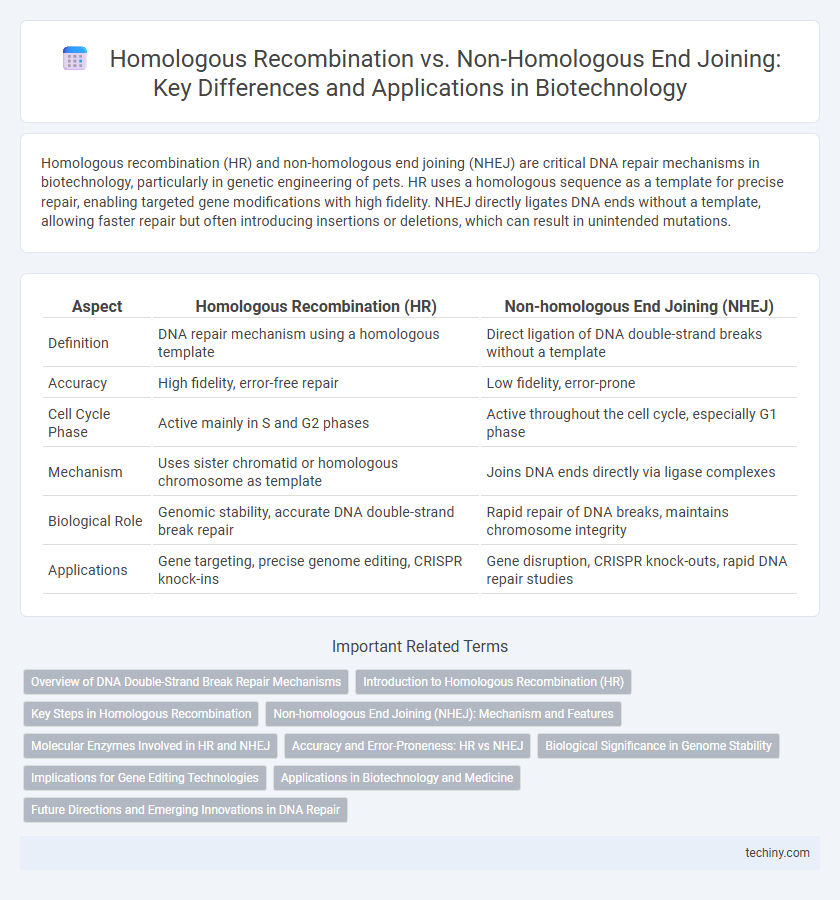Homologous recombination (HR) and non-homologous end joining (NHEJ) are critical DNA repair mechanisms in biotechnology, particularly in genetic engineering of pets. HR uses a homologous sequence as a template for precise repair, enabling targeted gene modifications with high fidelity. NHEJ directly ligates DNA ends without a template, allowing faster repair but often introducing insertions or deletions, which can result in unintended mutations.
Table of Comparison
| Aspect | Homologous Recombination (HR) | Non-homologous End Joining (NHEJ) |
|---|---|---|
| Definition | DNA repair mechanism using a homologous template | Direct ligation of DNA double-strand breaks without a template |
| Accuracy | High fidelity, error-free repair | Low fidelity, error-prone |
| Cell Cycle Phase | Active mainly in S and G2 phases | Active throughout the cell cycle, especially G1 phase |
| Mechanism | Uses sister chromatid or homologous chromosome as template | Joins DNA ends directly via ligase complexes |
| Biological Role | Genomic stability, accurate DNA double-strand break repair | Rapid repair of DNA breaks, maintains chromosome integrity |
| Applications | Gene targeting, precise genome editing, CRISPR knock-ins | Gene disruption, CRISPR knock-outs, rapid DNA repair studies |
Overview of DNA Double-Strand Break Repair Mechanisms
DNA double-strand break (DSB) repair mechanisms primarily include homologous recombination (HR) and non-homologous end joining (NHEJ), which maintain genomic stability. HR uses a homologous DNA template for accurate repair during the S and G2 phases of the cell cycle, ensuring high-fidelity restoration of genetic information. In contrast, NHEJ quickly ligates broken DNA ends without a template and operates throughout the cell cycle, frequently leading to small insertions or deletions at the repair site.
Introduction to Homologous Recombination (HR)
Homologous recombination (HR) is a precise DNA repair mechanism that utilizes an intact homologous sequence as a template to accurately repair double-strand breaks. This pathway is essential for maintaining genomic stability during the S and G2 phases of the cell cycle when sister chromatids are available. HR involves key proteins such as RAD51, BRCA1, and BRCA2, which facilitate strand invasion and exchange to restore genetic information without introducing mutations.
Key Steps in Homologous Recombination
Homologous recombination involves precise repair of DNA double-strand breaks using a homologous sequence as a template, initiating with DNA end resection to generate single-stranded DNA overhangs. The single-stranded DNA then undergoes strand invasion facilitated by RAD51, forming a displacement loop (D-loop) that promotes accurate DNA synthesis. Resolution of the Holliday junctions completes the repair, ensuring genomic stability and high-fidelity restoration of the damaged DNA.
Non-homologous End Joining (NHEJ): Mechanism and Features
Non-homologous End Joining (NHEJ) is a DNA repair mechanism that directly ligates broken DNA double-strand ends without the need for a homologous template. Key proteins involved in NHEJ include Ku70/Ku80 heterodimer, DNA-PKcs, and DNA ligase IV, which coordinate the recognition, processing, and sealing of DNA breaks. NHEJ is typically faster than homologous recombination but can introduce small insertions or deletions, making it error-prone yet essential for maintaining genomic stability, especially in non-dividing cells.
Molecular Enzymes Involved in HR and NHEJ
Homologous recombination (HR) involves key molecular enzymes such as RAD51, which facilitates strand invasion and homology search, and BRCA1/BRCA2, which regulate DNA repair complex assembly. Non-homologous end joining (NHEJ) primarily relies on the Ku70/Ku80 heterodimer to recognize DNA double-strand breaks, and DNA-PKcs, which activates the end-processing machinery. Ligase IV, in complex with XRCC4 and XLF, finalizes DNA ligation in NHEJ, highlighting distinct molecular pathways governing precise versus error-prone DNA repair mechanisms.
Accuracy and Error-Proneness: HR vs NHEJ
Homologous recombination (HR) provides high accuracy in DNA repair by using a homologous sequence as a template to ensure precise restoration of the original DNA sequence. Non-homologous end joining (NHEJ) is more error-prone due to direct ligation of DNA ends without a template, often resulting in insertions or deletions at the repair site. The fidelity of HR makes it essential for maintaining genomic stability, while NHEJ's speed and versatility accommodate repairs when no homologous template is available.
Biological Significance in Genome Stability
Homologous recombination ensures high-fidelity DNA double-strand break repair by using a sister chromatid as a template, maintaining genome stability and preventing mutations during cell division. Non-homologous end joining rapidly repairs breaks without a template, which can lead to insertions or deletions and increased genomic instability. The balance between these pathways is crucial for preserving genetic information and preventing diseases such as cancer.
Implications for Gene Editing Technologies
Homologous recombination (HR) enables precise gene editing by using a homologous DNA template to repair double-strand breaks, crucial for targeted genome modifications in CRISPR-Cas9 applications. Non-homologous end joining (NHEJ) is an error-prone repair mechanism that often introduces insertions or deletions, leading to gene disruptions commonly exploited for knockout studies. Choosing between HR and NHEJ pathways directly impacts the efficiency and accuracy of gene editing technologies, influencing therapeutic outcomes and genomic stability.
Applications in Biotechnology and Medicine
Homologous recombination enables precise genome editing by facilitating accurate DNA repair using a homologous template, making it essential for targeted gene therapy and developing genetically modified organisms. Non-homologous end joining offers a quicker, template-independent repair mechanism, beneficial for creating gene knockouts and studying gene functions in biomedical research. Both pathways are critical in CRISPR-Cas9 technologies, where homologous recombination aids in precise gene insertion, while non-homologous end joining allows efficient gene disruption.
Future Directions and Emerging Innovations in DNA Repair
Advancements in gene editing technologies prioritize enhancing homologous recombination efficiency to achieve precise DNA sequence corrections, while emerging innovations in non-homologous end joining focus on improving repair fidelity to reduce mutagenic outcomes. Novel CRISPR-based approaches integrate programmable nucleases with engineered repair templates to bias cellular machinery toward homology-directed repair pathways. Ongoing research explores synthetic biology tools and machine learning algorithms to predict and manipulate DNA repair pathway choice, paving the way for tailored therapeutic interventions and improved genome stability in clinical applications.
Homologous Recombination vs Non-homologous End Joining Infographic

 techiny.com
techiny.com